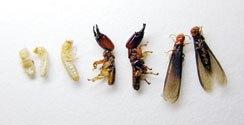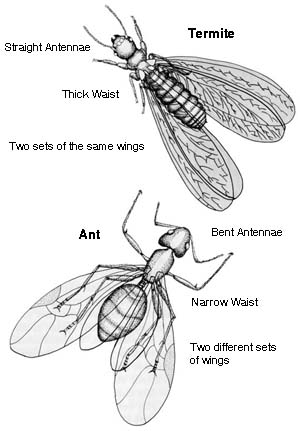Drywood Termite Treatments
Fumigation:
 Fumigation involves covering the residence with a tent and releasing Vikane Gas into the property. The complete fumigation process takes up to three days and occupants must be vacated from the premises. Although more expensive and troublesome to occupants, Fumigation is the #1 method of eliminating drywood termite infestations in all areas of the structure even if you can’t see them.
Fumigation involves covering the residence with a tent and releasing Vikane Gas into the property. The complete fumigation process takes up to three days and occupants must be vacated from the premises. Although more expensive and troublesome to occupants, Fumigation is the #1 method of eliminating drywood termite infestations in all areas of the structure even if you can’t see them.
Spot Treatment:
Localized treatment or "Spot" treatment has many benefits to the homeowner. No moving out of the property over night, and no damage to roofing or plants. Once a complete inspection has been performed we can recommend a treatment to address each area of concern to exterminate the termite colonies.
About Drywood Termites
 Drywood termitesTermites eat wood, and can consequently cause great structural damage to your home if left unchecked. A typical homeowner’s insurance policy does not cover destruction caused by termites, even though they cause over 1 billion dollars in damage to homes throughout the United States each year. Our inspection and treatment program can help you understand the threat of termites, and take the necessary steps to protect your home.
Drywood termitesTermites eat wood, and can consequently cause great structural damage to your home if left unchecked. A typical homeowner’s insurance policy does not cover destruction caused by termites, even though they cause over 1 billion dollars in damage to homes throughout the United States each year. Our inspection and treatment program can help you understand the threat of termites, and take the necessary steps to protect your home.Drywood Termites are up to one-half inch long. Drywood termites create colonies in wood and require very little moisture to survive. Unlike Subterranean Termites, they don't require any direct connection to soil. They eat all types of wood and occasionally other cellulose material like cardboard or books. Drywood Termite infestations can exist for long periods of time before being discovered, often eating wood away but leaving the paint in place.
The most common evidence of Drywood Termites is small piles of sawdust colored pellets that fall from kick-out holes made by the termites. Just one or two pellets is difficult to see, but over time an active colony will create thousands of these pellets making their presence more obvious.
Termite Colonies:

KING AND QUEEN
At least one King and Queen are at the center of every termite colony. The Queens sole purpose is to reproduce. Some live for as long as 30 years.
EGGS
Queens can lay thousands of eggs every year. Eggs hatch into Nymphs.
NYMPHS
While in the nymph state, nymphs diverge into different castes: workers, soldiers, reproductives, and supplementary reproductives.
WORKERS
Workers are blind, wingless termites that maintain the colony, build and repair the nest and tubes, forage for food, and care for the other termites. They are the most numerous caste and the most likely to be found in infested wood.
SOLDIERS
Soldiers are sterile, wingless, and blind. Their sole function is to defend the colony.
WINGED REPRODUCTIVES
These termites will eventually leave the colony as Adult Swarmers. After swarming, they shed thier wings and pair up. Each male-female pair attempts to start a new colony.
SUPPLEMENTARY REPRODUCTIVES
These termites help increase the population of established colonies and serve as replacments for the King or Queen if they should die.
Is it a termite or an ant?
On the off chance you do see them, remember that it’s easy to confuse termites with ants. Fortunately, there are features that distinguish them.

